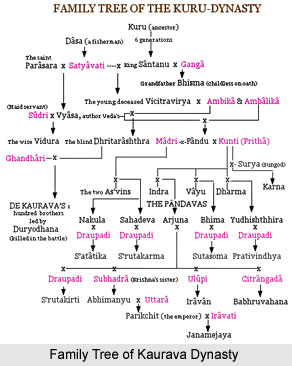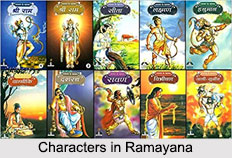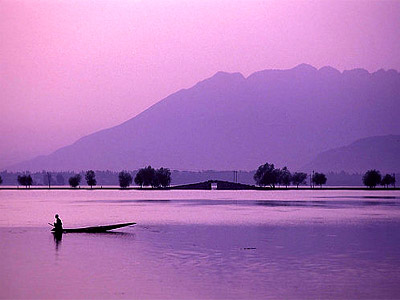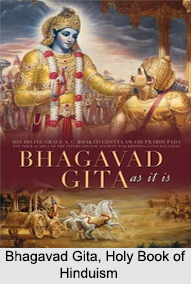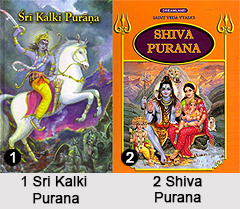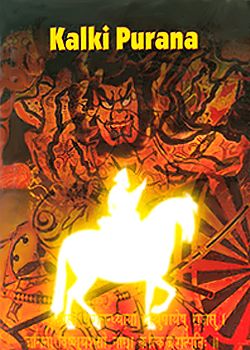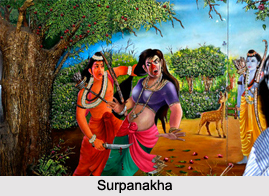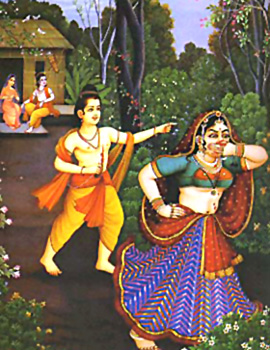 Forest life of Rama, Lakshmana and Sita forms the opening part of the Aranya Kanda. The wandering life of the two brothers and Sita in the forest is the main description of the episode. Both Rama and Lakshmana protected the sages from the devilish rakshasas in the jungle and they lived in the jungle peacefully. While staying in the forest they once met the vulture Jatayu who introduced himself to the tow brothers as a fried of king Dasaratha of Ayodhya. Jatayu promised that he would guard Sita when the two brothers were away. Lastly, Rama, Lakshmana and Sita settled in the Panchavati forest. Lakshmana constructed a spacious bamboo house there, well-thatched with leaves and with a well-smoothed floor. While staying in the hermitage at Panchavati they also confronted Surpanakha, demon king Ravana`s sister whose nose and ears were chopped by Lakshmana since she tried to kill Sita. Both the brothers also killed several other asuras in the jungle along with Khara, younger brother of Ravana.
Forest life of Rama, Lakshmana and Sita forms the opening part of the Aranya Kanda. The wandering life of the two brothers and Sita in the forest is the main description of the episode. Both Rama and Lakshmana protected the sages from the devilish rakshasas in the jungle and they lived in the jungle peacefully. While staying in the forest they once met the vulture Jatayu who introduced himself to the tow brothers as a fried of king Dasaratha of Ayodhya. Jatayu promised that he would guard Sita when the two brothers were away. Lastly, Rama, Lakshmana and Sita settled in the Panchavati forest. Lakshmana constructed a spacious bamboo house there, well-thatched with leaves and with a well-smoothed floor. While staying in the hermitage at Panchavati they also confronted Surpanakha, demon king Ravana`s sister whose nose and ears were chopped by Lakshmana since she tried to kill Sita. Both the brothers also killed several other asuras in the jungle along with Khara, younger brother of Ravana.
Rama and Sita and Lakshmana wandered through the forest, welcome guests at every hermitage. The great sages dwelling in the hermitages also complained against those devilish rangers of the night, and besought Rama`s protection against them, which he freely promised and when the gentle Sita one day suggested that they should lay down their arms, abandoning the rule of knights for that of saints, and ceasing from hostility even against the rakshasas, Rama answered that it might not be, for he was pledged by knightly duty and personal promise.
So Rama dwelt in the forest for ten years, staying a month, a season, or a year at one or another hermitage. Once a fierce rakshasa named Viradha seized Sita and would have carried her off, but Rama and Lakshmana with huge labour slew him. Another time they met a mighty vulture, who introduced him as Jatayu and as the fried of the great king Dasaratha of Ayodhya. Jatayu promised Rama his help and to guard Sita when Rama and Lakshmana went abroad together.
Last of all, Rama, Sita and Lakshmana came to Panchavati, where stretched a fair lawn beside the River Godavari, whose banks were overhung by flowery trees. The waters swarmed with foul, throngs of deer dwelt in the woods, the cries of peacocks resounded, and the hills were covered with good trees and flowers and herbs. There Lakshmana constructed a large and spacious bamboo house, well-thatched with leaves and with a well-smoothed floor. Rama, Sita and Lakshmana were contented, like the gods in heaven.
Surpanakha Punished by Lakshmana
Once Rama was seated with Sita, talking to Lakshmana, when there came to Panchavati a fearful and hideous rakshasi, sister of Ravana and when she saw Rama, she immediately desired him. Her name was Surpanakha. Refused by Rama she went to Lakshmana who also refused her. She then came back to Rama and tried to kill Sita. Then Lakshmana seized his sword and cut off her nose and ears, and she flew bleeding profusely to her brother Khara, younger brother of Ravana. Khara became very angry at the misfortune of his sister and sent fourteen rakshasas to kill the two brothers and Sita and to bring their blood for his sister Surpanakha to drink. But Rama slew all those evil creatures with his arrows.
After hearing about the death of the fourteen asuras sent by him, Khara became more furious and set out himself with fourteen thousand asuras. As this host drove on several evil omens befell, but Khara was fey and not to be turned aside from what he deemed a small matter to slay the three simple human beings. Rama, comprehending the oncoming host, sent Lakshmana with Sita to a secret cave, and cast on his mail, for he would fight alone, and all the gods and spirits of the air and creatures of heaven came to behold the battle. The rakshasas came on like a sea, or heavy clouds, and showered their weapons upon Rama, so that the wood gods were afraid and fled away.
Rama was not at all afraid and troubled the rakshasas with his marrow-piercing shafts, so that they fled to Khara for protection. He rallied them, and they came on again, discharging volleys of uprooted trees and boulders. It was in vain, for Rama, alone fighting on foot slew all the fourteen thousand rakshasas and stood face to face with Khara himself. A dreadful battle took place, as if between a lion and an elephant, the air was dark with flying shafts. At last a fiery arrow discharged by Rama consumed the life of the demon Khara. Then the gods, well pleased, showered blossoms upon Rama, and departed and Sita and Lakshmana came out of the cave.
The forest life of the two brothers Rama and Lakshmana along with Sita forms the opening part of the Aranya Kanda. Here, vivid description of the Panchavati forest has been given where Rama, Lakshmana and Sita lived in a hermitage well-constructed by Lakshmana. The incident of Ravana`s sister Surpanakha`s nose and ear chopping by Lakshmana and the killing of a large number of rakshasas along with Khara by Rama are elaborately described. When the news of Khara`s death and Surpanakha`s insult at the hands of the two brothers reached Ravana, he determined to take revenge from them by abducting Sita.













